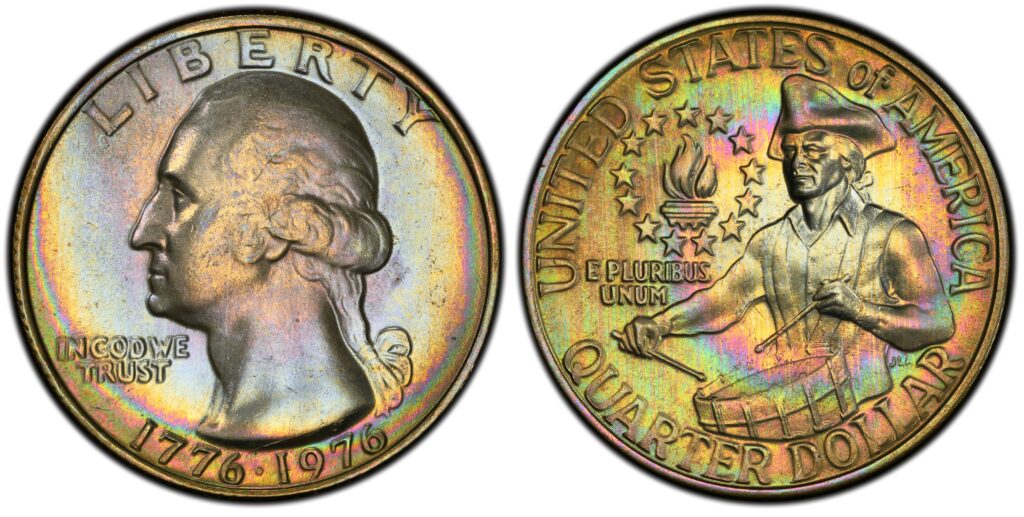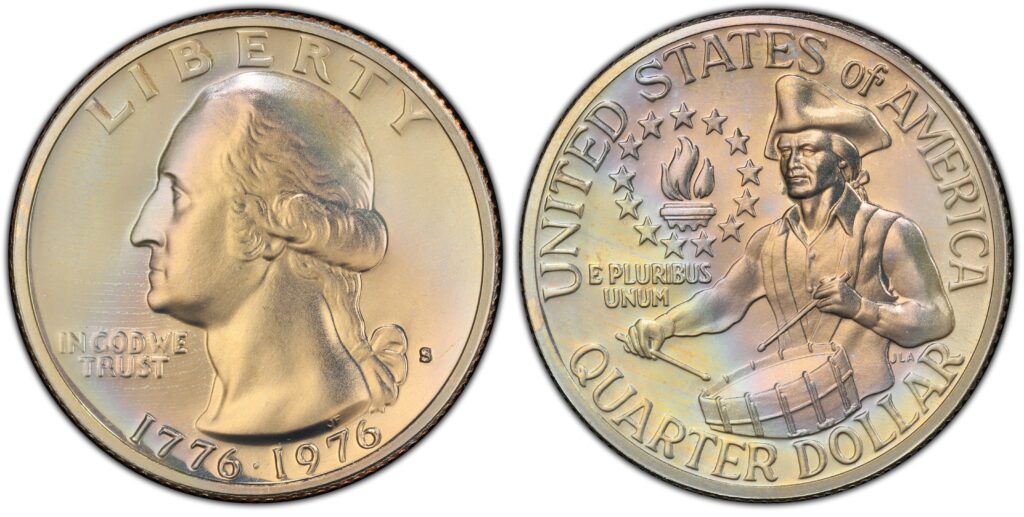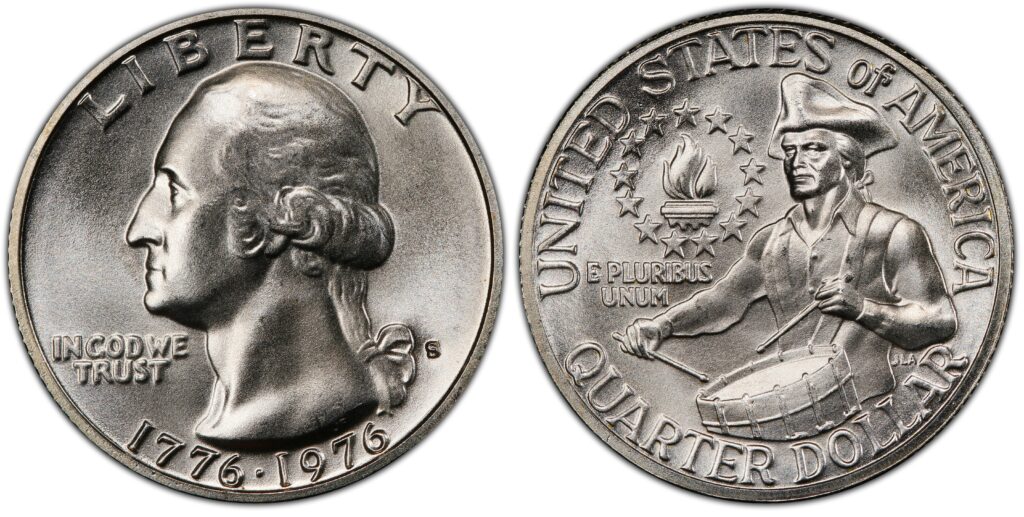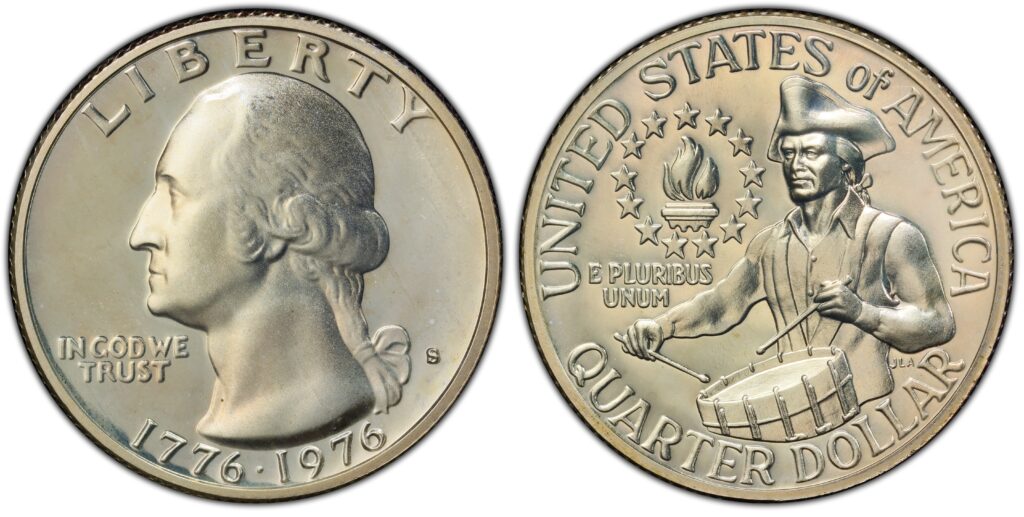What Is A 1976 Washington Quarter Made Of?
The 1976 Washington quarter is a copper-nickel-clad coin that is composed of 75% copper and 25% nickel. It has a core of pure copper and is covered by a mixture of copper and nickel.
The face value of the 1976 Washington quarter is 25 cents or 0.25 USD. It has a mass of 5.67 grams and a diameter of 24.3 mm.
Although the standard Washington quarter in 1976 was made of copper and nickel, there were special editions of the quarter that the U.S. Mint also made. There were also the 1776-1976 uncirculated, proof silver clad quarters with 40% silver.
Please note that the 1976 Washington quarter was made in 1975 and 1976 bear two dates, which are 1776-1976. The reason is that 1976 marked the 200th birth of the United States. Thus, the U.S. decided to create commemorative quarter coins along with the dollar and half-dollar coins.
You will not find any quarter coin that has 1975 or 1976 dates. You’ll only find the dual dates.
The 1976 quarter essentially has the same obverse. Only the reverse was temporarily changed in commemoration of the 200th anniversary of the United States Declaration of Independence.

The obverse featured the left profile of George Washington. Inscriptions include the following:
- LIBERTY
- IN GOD WE TRUST
- 1776-1976
- Mint mark (if present)
Originally, the reverse side of the quarter is the United States eagle. For the years 1975 and 1976, the eagle was replaced by the colonial drummer facing left. Aside from that, you’ll find the victory torch encircled by 13 stars on the left side of the drummer.
Inscriptions on the reverse include the following:
- UNITED STATES OF AMERICA
- E PLURIBUS UNUM
- QUARTER DOLLAR
To decide what design to add to the reverse of the commemorative quarter coin, the U.S. Mint held a national competition, which was open to all US sculptors. Jack Ahr won the competition with his colonial drummer. The 1776-1976 quarter was later best known as the drummer boy quarters.
How To Differentiate Between Clad And Silver 1976 Quarters?
After the production was over, there were about 11 million silver quarters and 4 million silver proof quarters made in the U.S. As impressive as these numbers are, there are way more copper-nickel 1976 quarters.
So, you might wonder, how can I know if my 1976 quarter is made of silver or not?
The first thing you should do is check the reed or edge of the coin. If you see a solid whitish or silvery color, then what you have in your hand is most likely a silver coin. Contrast that to a copper-nickel clad quarter that has a thin line of reddish copper mixed with whitish nickel.
Another tip is to check the weight. Silver quarters with 6.25 grams of weight are heavier than copper-nickel quarters, which only have 5.7 grams.
Moreover, if you have an old coin, you’ll notice that silver quarters tarnish over time. This is not the case with copper-nickel quarters, which will be covered with copper tint instead.
You can also do a drop test. Try to drop your coin and listen to the sound it makes. Copper-nickel quarters have a dull thud while silver coins make a higher pitched sound.
When in doubt, it doesn’t hurt to consult a qualified coin dealer. They can confirm to you whether you have a silver or non-silver 1976 quarter.
1976 Washington Quarter Varieties
The 1976 quarters or 1776-1976 quarters come with various designs. Mostly, the difference has to do with their mint mark. There are also quarters made with errors, which gave rise to a different variety.
To get familiar with these varieties, take a look at the list below:
1976 Washington Quarter With No Mint Mark
Edge: Reeded
Mint Mark: No mint mark
Place of minting: Philadelphia
Year: 1975 to 1976
Face Value: $0.25 (twenty-five cents)
Price: $0.25 to $5.50 (or more)
Quantity produced: 809,784,016
Composition: 75% copper and 25% nickel
Mass: 5.67 grams
Diameter: 24.3 mm
Thickness: 1.75 mm

The 1976 Quarter with a mint mark of D has a selling price of $.025 to $5.50 or more if it has special features. The Denver Mint produced 860,118,839 of these coins.
1976 S Washington Quarter Proof
Edge: Reeded
Mint Mark: S
Place of minting: San Francisco
Year: 1975 to 1976
Face Value: $0.25 (twenty-five cents)
Price: $0.25 to $5.50 (or more)
Quantity produced: 7,059,099
Composition: 75% copper and 25% nickel
Mass: 5.75 grams
Diameter: 24.3 mm
Thickness: 1.75 mm

The 1976 S Quarter Proof has a selling price of $.25 to $5.50 or more if it has unique features. The San Francisco Mint produced 7,059,099 of these coins. Since these are proof coins, you’ll see them with a better visual appeal, more popped-out details, and a shiny look.
1976 S Silver Washington Quarter
Edge: Reeded
Mint Mark: S
Place of minting: San Francisco
Year: 1975 to 1976
Face Value: $0.25 (twenty-five cents)
Price: $0.25 to $3.40 (or more)
Quantity produced: 11,000,000
Composition: 40% silver and 60% copper
Mass: 6.25 grams
Diameter: 24.3 mm
Thickness: 1.75 mm

The 1976 S Quarter Silver quarter has a selling price of $.025 to $3.40 or more if it has rare and impressive features. The San Francisco Mint produced 11,000,000 of these coins. It is made of 40% silver and 60% copper.
1976 S Quarter Silver Proof
Edge: Reeded
Mint Mark: S
Place of minting: San Francisco
Year: 1975 to 1976
Face Value: $0.25 (twenty-five cents)
Price: $0.25 to $5.95 (or more)
Quantity produced: 4,000,000
Composition: 40% silver and 60% copper
Mass: 6.25 grams
Diameter: 24.3 mm
Thickness: 1.75 mm

The 1976 S Quarter Silver Proof quarter has a selling price of $.025 to $5.95 or more if it has unique and impressive features. The San Francisco Mint produced 4,000,000 of these coins. Proof coins are usually not part of the circulation. They are sold to coin collectors.
1976 quarter errors
No minting process is perfectly done. With millions of coins produced, it is inevitable that a few of the coins would not properly be struck or minted. Thus, the 1776-1976 quarter is not an exemption.
Here are some known 1976 quarter errors you might find interesting:
- 1976 Quarter Doubled Die – this quarter was died twice and you can see a doubling of some of the elements.
- bicentennial colonial drummer quarters with errors – the coin was struck through grease and thus, the engraved drummer image isn’t as pronounced as it should be.
- Off center obverse – as the planchet was not properly mounted, the die struck it inaccurately.
- Broadstrike quarter – the strike was so big that the strike went outside of the coin.
How Much Is A 1976 Quarter Worth Today?
The ordinary 1976 quarter’s worth is the same as its face value, $0.25. The copper-nickel quarter’s melt value is $0.25. However, the silver coin variation’s melt value is $1.43 as of September 21, 2022.
The value of your 1776-1976 quarter coin can dramatically increase if it is in good condition and has rare or impressive attributes. Moreover, once your coin is officially graded, you can demand a higher price as suggested by the grade you received.
Just to give you an example, here’s a table to help you get an overview of the price of a 1976 quarter.
| Coin | Condition | Grade | Price |
| Standard 1776-1976 clad quarters | Circulated | Not graded | $0.25 |
| 1776-1976 quarter with no mint mark | Uncirculated | MS 63 | $1.25 |
| 1776-1976 D quarter | Uncirculated | MS 63 | $1.25 |
| 1776-1976 quarter with no mint mark | Uncirculated | MS 65 | $6.00 |
| 1776-1976 D quarter | Uncirculated | MS 65 | $6.00 |
| 1776-1976 S proof quarter | Uncirculated | PR 65 | $5.00 |
| 1776-1976 Silver Clad Quarters | Circulated | Not graded | Same as its melt value ($1.45) |
| 1776-1976 S silver quarter | Uncirculated
|
MS 63 | $5.00 |
| 1776-1976 S silver quarter | Uncirculated
|
MS 65 | $7.00 |
| 1776-1976 S silver proof quarter | Uncirculated | PR 65 | $8 |
How Does The Grading System Work?
The Sheldon Scale is used by numismatists to provide a numerical value to coins. The Sheldon Scale goes from poor (P-1) to perfect mint state (P-1) (MS-70). Coins were originally evaluated using words to reflect their condition (Good, Fair, Excellent, Etc.). Unfortunately, coin collectors and dealers had different ideas about what each of these terms represent.
Professional numismatists joined together in the 1970s and established CoinGrading standards. These numismatists now assign grades at key places on the seventy-point scale, using the most regularly utilized numeric points in conjunction with the original adjective grade. The following are the most common coin grades:
-
-
- (P-1) Poor – Indistinguishable and probably damaged; if used, must have a date and mintmark; otherwise, rather battered.
- (FR-2) Fair – Nearly smooth, but without the damage that a coin graded Poor often possesses. The coin must have enough detail to be identified.
- (G-4) Fair – Inscriptions have merged into the rims in some areas, and important elements have been mostly erased.
- (VG-8) Very Good- A little weathered, but all of the primary design elements are visible, albeit faintly. There is little if any, central detail left.
- (F-12) Good – The item is very worn, yet the wear is even, and the overall design details stand out clearly. Rims are almost completely isolated from the field.
- (VF-20) Very Fine – Moderately weathered, with some finer features still visible. The motto or all letters of LIBERTY are readable. Both sides of the coin have entire rims that are separated from the field.
- (EF-40) Extremely Fine – Gently used; all gadgets are visible, and the most important ones are bold. The finer details are bold and clear, however, light wear may be seen.
- (AU-50) Uncirculated – Slight evidence of wear on the coin’s design’s high points; may have contact marks; eye appeal should be adequate.
- (AU-58) Uncirculated Choice – Slight traces of wear, no severe contact marks, almost full mint shine, and great eye appeal.
- (MS-60) Mint State Basal – Strictly uncirculated; no indication of wear on the coin’s highest points, but an unsightly coin with reduced luster, visible contact marks, hairlines, and other flaws.
- (MS-63) Mint State Acceptable – Uncirculated, but with contact scratches and nicks, little reduced shine, but otherwise appealing appearance. The strike is weak to average.
- (MS-65) Mint State Choice – Uncirculated with great mint shine, very little contact blemishes, and exceptional eye appeal. The strike is unusually severe.
- (MS-68) Mint State Premium Quality – Uncirculated with superb luster, no obvious contact marks to the naked eye, and exceptional eye appeal. The strike is quick and appealing.
- (MS-69) Almost Perfect Mint State – Uncirculated with perfect brilliance, a sharp and appealing strike, and extremely good eye appeal. A near-perfect coin with minor imperfections in the planchet, strike, and contact markings (seen only under 8x magnification).
- (MS-70) Mint State Perfect – Under 8x magnification, there are no tiny imperfections discernible; the strike is crisp, and the coin is perfectly centered on a beautiful planchet. Rarely seen on a coin, this coin is bright and whole, with original luster and exceptional eye appeal.
-
Where To Buy Or Sell 1976 Quarters?
The Internet is a great place to buy or sell 1976 quarters. Websites such as Facebook marketplace, Amazon, and eBay are the most popular go-to places online. However, there are also other websites that specialize in selling and buying U.S. coins. A simple Google search should reveal a few of these top websites.
Alternatively, you can go to physical stores where you can buy or sell coins. Locations such as coin shops, coin exchanges, and coin collectors hubs should be good places to start your search.
With over 1.7 billion of 1776-1976 quarters made, you should easily find them. They are not rare coins and you can even find 1976 coins in circulation.
FAQs
What is the melt value of a 1976 bicentennial quarter?
The melt value of a 1976 bicentennial quarter is $0.25, which is the same as its face value. However, the silver 1976 bicentennial quarter has a melt value of $1.43 as of the time of this writing. Please note that the melt value of silver changes. So, you need to always get the most updated melt value.
What does it mean when there is no mint mark on a coin?
If there’s no mint mark, the coin is most likely struck in the Philadelphia Mint.
Where is the mint mark located on a 1976 quarter?
The mint mark is found on the right side of George Washington’s image, just below his ponytail.
How much is a 1976 bicentennial quarter?
The 1976 bicentennial quarter is worth $0.25. Quarters in the mint state can be sold for about $5. Price can easily go up if you have a quarter coin with rare attributes. One example is the Denver Washington bicentennial quarter in MS68 status. Some sellers have earned $3,220 to $6,463 by selling these coins.
